Self-Reflection and Evaluation: TPR Assessment in Nursing Practice
VerifiedAdded on 2023/06/11
|8
|1968
|265
Essay
AI Summary
This essay presents a self-reflection on a Temperature, Pulse, and Respiration (TPR) assessment, guided by the Gibbs reflection model and aligned with the Nursing and Midwifery Board of Australia (NMBA) Registered Nurse Standards for Practice (2016). The reflection encompasses a description of the assessment process, personal feelings and thoughts during the procedure, an evaluation of skills and competence, and an analysis of the events that occurred. Strengths identified include creating a conducive environment, establishing rapport with the client, employing appropriate techniques, and documenting findings promptly. Weaknesses include asking questions that suggested a lack of preparation. The essay concludes with an action plan for future practice, emphasizing the importance of mastering patient history, explaining procedures thoroughly, and continuous documentation to facilitate teamwork. The student ultimately assesses the procedure as successful in meeting NMBA and NCAS guidelines, with identified shortcomings addressed through a commitment to ongoing improvement.
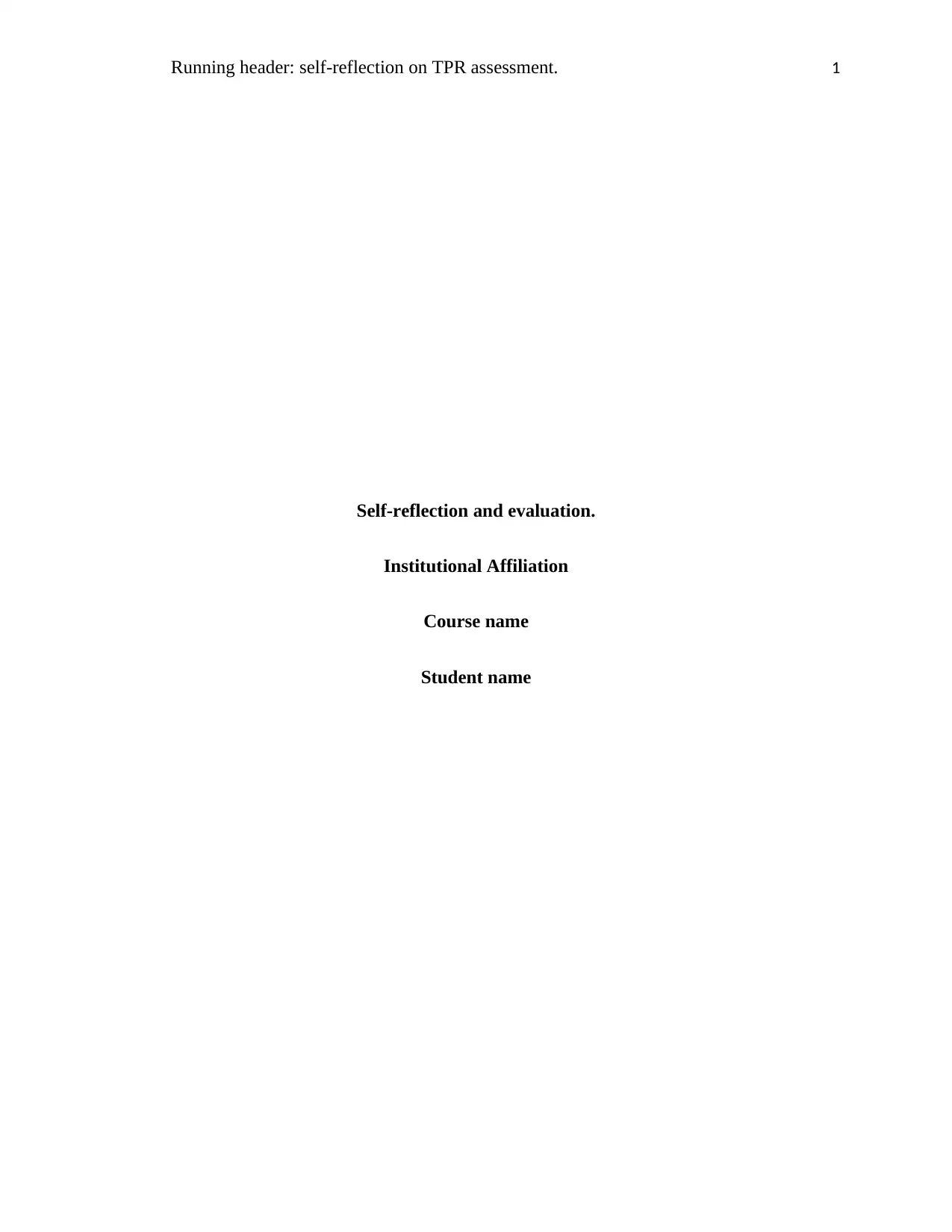
Running header: self-reflection on TPR assessment. 1
Self-reflection and evaluation.
Institutional Affiliation
Course name
Student name
Self-reflection and evaluation.
Institutional Affiliation
Course name
Student name
Paraphrase This Document
Need a fresh take? Get an instant paraphrase of this document with our AI Paraphraser
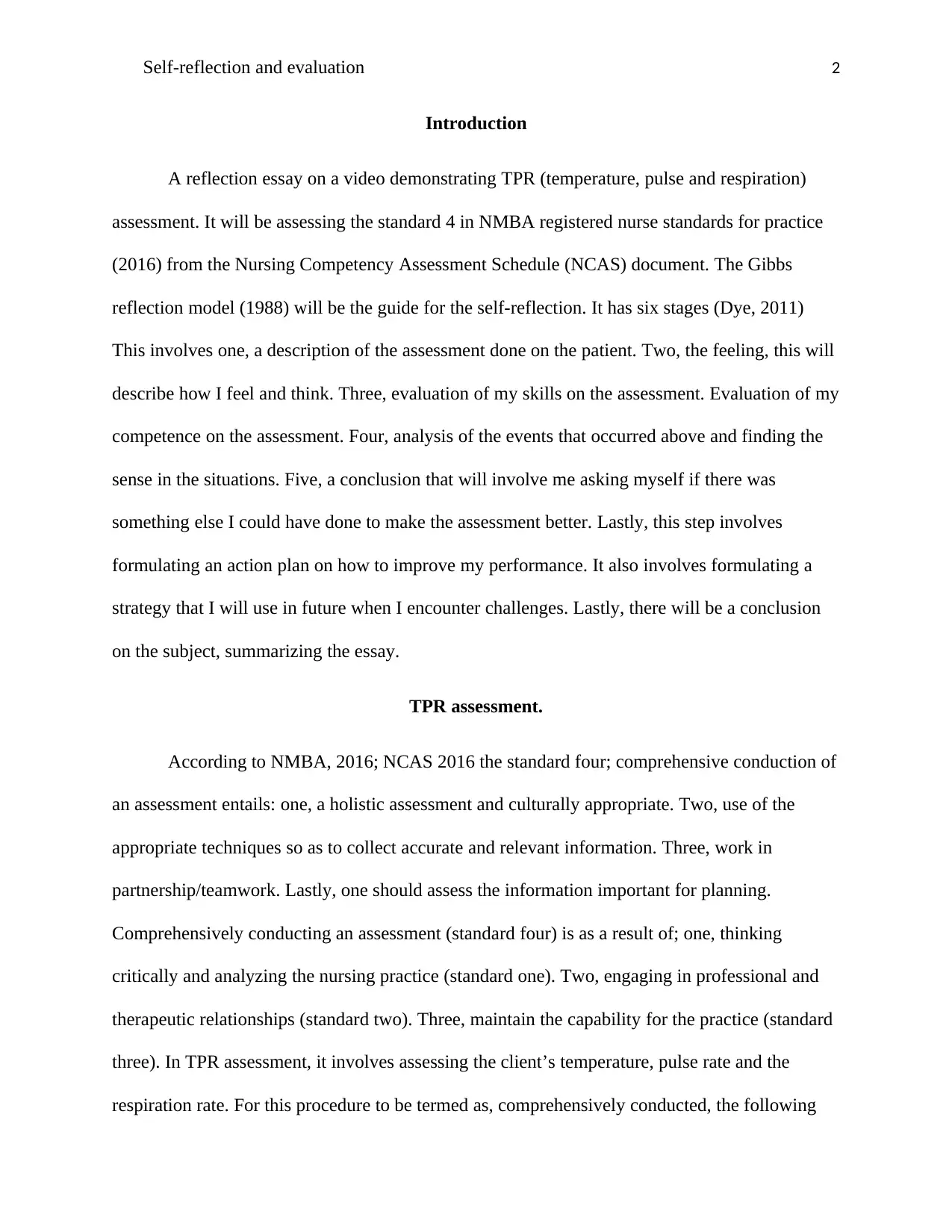
Self-reflection and evaluation 2
Introduction
A reflection essay on a video demonstrating TPR (temperature, pulse and respiration)
assessment. It will be assessing the standard 4 in NMBA registered nurse standards for practice
(2016) from the Nursing Competency Assessment Schedule (NCAS) document. The Gibbs
reflection model (1988) will be the guide for the self-reflection. It has six stages (Dye, 2011)
This involves one, a description of the assessment done on the patient. Two, the feeling, this will
describe how I feel and think. Three, evaluation of my skills on the assessment. Evaluation of my
competence on the assessment. Four, analysis of the events that occurred above and finding the
sense in the situations. Five, a conclusion that will involve me asking myself if there was
something else I could have done to make the assessment better. Lastly, this step involves
formulating an action plan on how to improve my performance. It also involves formulating a
strategy that I will use in future when I encounter challenges. Lastly, there will be a conclusion
on the subject, summarizing the essay.
TPR assessment.
According to NMBA, 2016; NCAS 2016 the standard four; comprehensive conduction of
an assessment entails: one, a holistic assessment and culturally appropriate. Two, use of the
appropriate techniques so as to collect accurate and relevant information. Three, work in
partnership/teamwork. Lastly, one should assess the information important for planning.
Comprehensively conducting an assessment (standard four) is as a result of; one, thinking
critically and analyzing the nursing practice (standard one). Two, engaging in professional and
therapeutic relationships (standard two). Three, maintain the capability for the practice (standard
three). In TPR assessment, it involves assessing the client’s temperature, pulse rate and the
respiration rate. For this procedure to be termed as, comprehensively conducted, the following
Introduction
A reflection essay on a video demonstrating TPR (temperature, pulse and respiration)
assessment. It will be assessing the standard 4 in NMBA registered nurse standards for practice
(2016) from the Nursing Competency Assessment Schedule (NCAS) document. The Gibbs
reflection model (1988) will be the guide for the self-reflection. It has six stages (Dye, 2011)
This involves one, a description of the assessment done on the patient. Two, the feeling, this will
describe how I feel and think. Three, evaluation of my skills on the assessment. Evaluation of my
competence on the assessment. Four, analysis of the events that occurred above and finding the
sense in the situations. Five, a conclusion that will involve me asking myself if there was
something else I could have done to make the assessment better. Lastly, this step involves
formulating an action plan on how to improve my performance. It also involves formulating a
strategy that I will use in future when I encounter challenges. Lastly, there will be a conclusion
on the subject, summarizing the essay.
TPR assessment.
According to NMBA, 2016; NCAS 2016 the standard four; comprehensive conduction of
an assessment entails: one, a holistic assessment and culturally appropriate. Two, use of the
appropriate techniques so as to collect accurate and relevant information. Three, work in
partnership/teamwork. Lastly, one should assess the information important for planning.
Comprehensively conducting an assessment (standard four) is as a result of; one, thinking
critically and analyzing the nursing practice (standard one). Two, engaging in professional and
therapeutic relationships (standard two). Three, maintain the capability for the practice (standard
three). In TPR assessment, it involves assessing the client’s temperature, pulse rate and the
respiration rate. For this procedure to be termed as, comprehensively conducted, the following
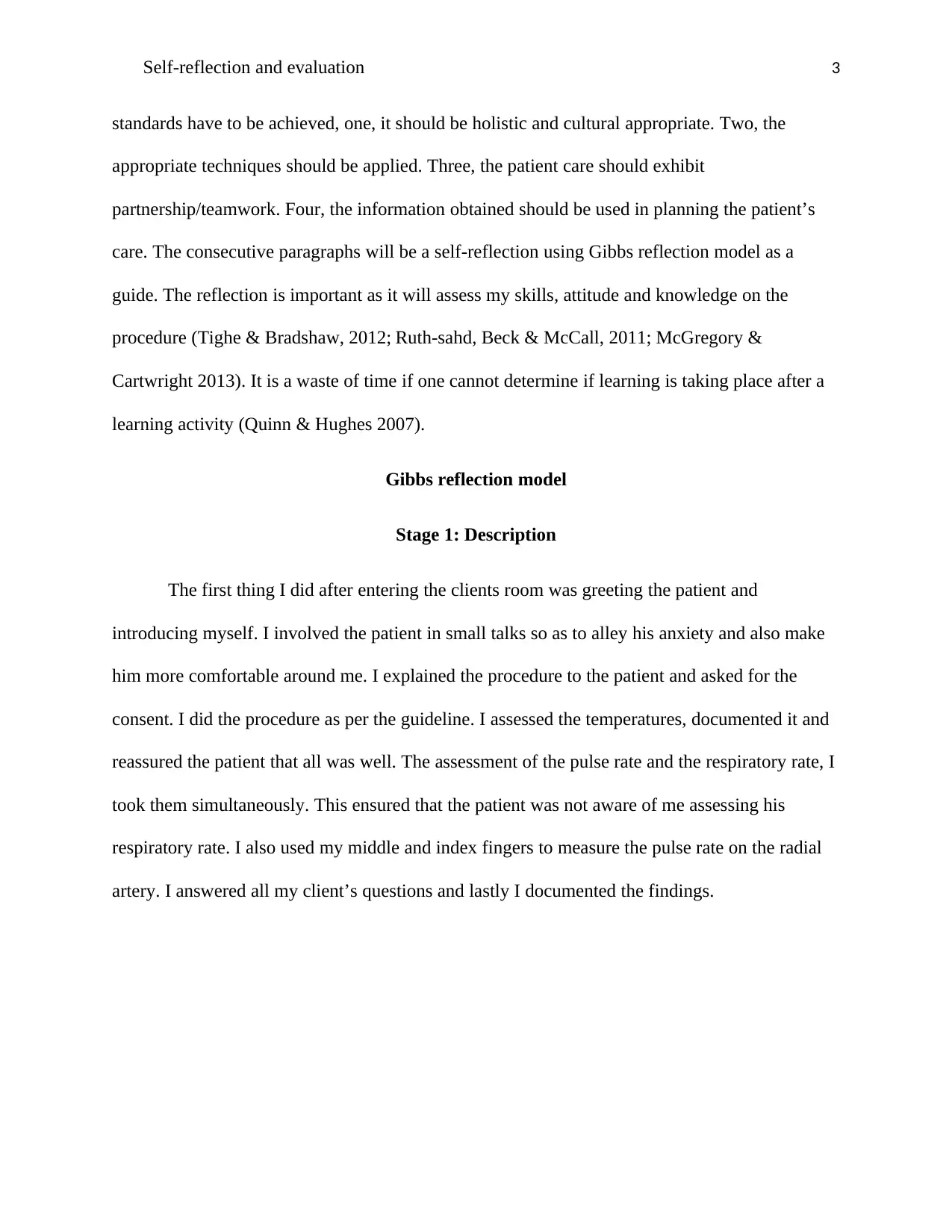
Self-reflection and evaluation 3
standards have to be achieved, one, it should be holistic and cultural appropriate. Two, the
appropriate techniques should be applied. Three, the patient care should exhibit
partnership/teamwork. Four, the information obtained should be used in planning the patient’s
care. The consecutive paragraphs will be a self-reflection using Gibbs reflection model as a
guide. The reflection is important as it will assess my skills, attitude and knowledge on the
procedure (Tighe & Bradshaw, 2012; Ruth-sahd, Beck & McCall, 2011; McGregory &
Cartwright 2013). It is a waste of time if one cannot determine if learning is taking place after a
learning activity (Quinn & Hughes 2007).
Gibbs reflection model
Stage 1: Description
The first thing I did after entering the clients room was greeting the patient and
introducing myself. I involved the patient in small talks so as to alley his anxiety and also make
him more comfortable around me. I explained the procedure to the patient and asked for the
consent. I did the procedure as per the guideline. I assessed the temperatures, documented it and
reassured the patient that all was well. The assessment of the pulse rate and the respiratory rate, I
took them simultaneously. This ensured that the patient was not aware of me assessing his
respiratory rate. I also used my middle and index fingers to measure the pulse rate on the radial
artery. I answered all my client’s questions and lastly I documented the findings.
standards have to be achieved, one, it should be holistic and cultural appropriate. Two, the
appropriate techniques should be applied. Three, the patient care should exhibit
partnership/teamwork. Four, the information obtained should be used in planning the patient’s
care. The consecutive paragraphs will be a self-reflection using Gibbs reflection model as a
guide. The reflection is important as it will assess my skills, attitude and knowledge on the
procedure (Tighe & Bradshaw, 2012; Ruth-sahd, Beck & McCall, 2011; McGregory &
Cartwright 2013). It is a waste of time if one cannot determine if learning is taking place after a
learning activity (Quinn & Hughes 2007).
Gibbs reflection model
Stage 1: Description
The first thing I did after entering the clients room was greeting the patient and
introducing myself. I involved the patient in small talks so as to alley his anxiety and also make
him more comfortable around me. I explained the procedure to the patient and asked for the
consent. I did the procedure as per the guideline. I assessed the temperatures, documented it and
reassured the patient that all was well. The assessment of the pulse rate and the respiratory rate, I
took them simultaneously. This ensured that the patient was not aware of me assessing his
respiratory rate. I also used my middle and index fingers to measure the pulse rate on the radial
artery. I answered all my client’s questions and lastly I documented the findings.
⊘ This is a preview!⊘
Do you want full access?
Subscribe today to unlock all pages.

Trusted by 1+ million students worldwide
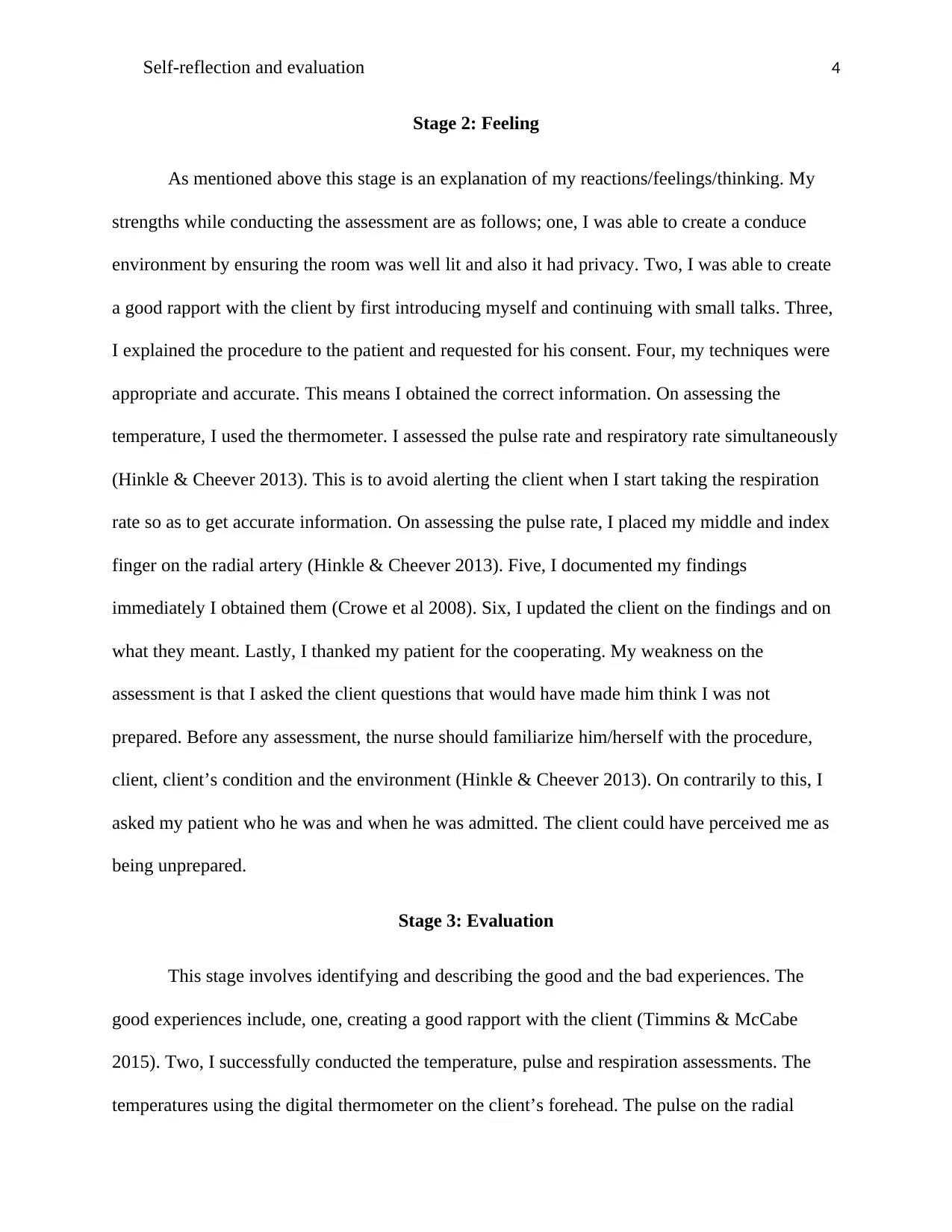
Self-reflection and evaluation 4
Stage 2: Feeling
As mentioned above this stage is an explanation of my reactions/feelings/thinking. My
strengths while conducting the assessment are as follows; one, I was able to create a conduce
environment by ensuring the room was well lit and also it had privacy. Two, I was able to create
a good rapport with the client by first introducing myself and continuing with small talks. Three,
I explained the procedure to the patient and requested for his consent. Four, my techniques were
appropriate and accurate. This means I obtained the correct information. On assessing the
temperature, I used the thermometer. I assessed the pulse rate and respiratory rate simultaneously
(Hinkle & Cheever 2013). This is to avoid alerting the client when I start taking the respiration
rate so as to get accurate information. On assessing the pulse rate, I placed my middle and index
finger on the radial artery (Hinkle & Cheever 2013). Five, I documented my findings
immediately I obtained them (Crowe et al 2008). Six, I updated the client on the findings and on
what they meant. Lastly, I thanked my patient for the cooperating. My weakness on the
assessment is that I asked the client questions that would have made him think I was not
prepared. Before any assessment, the nurse should familiarize him/herself with the procedure,
client, client’s condition and the environment (Hinkle & Cheever 2013). On contrarily to this, I
asked my patient who he was and when he was admitted. The client could have perceived me as
being unprepared.
Stage 3: Evaluation
This stage involves identifying and describing the good and the bad experiences. The
good experiences include, one, creating a good rapport with the client (Timmins & McCabe
2015). Two, I successfully conducted the temperature, pulse and respiration assessments. The
temperatures using the digital thermometer on the client’s forehead. The pulse on the radial
Stage 2: Feeling
As mentioned above this stage is an explanation of my reactions/feelings/thinking. My
strengths while conducting the assessment are as follows; one, I was able to create a conduce
environment by ensuring the room was well lit and also it had privacy. Two, I was able to create
a good rapport with the client by first introducing myself and continuing with small talks. Three,
I explained the procedure to the patient and requested for his consent. Four, my techniques were
appropriate and accurate. This means I obtained the correct information. On assessing the
temperature, I used the thermometer. I assessed the pulse rate and respiratory rate simultaneously
(Hinkle & Cheever 2013). This is to avoid alerting the client when I start taking the respiration
rate so as to get accurate information. On assessing the pulse rate, I placed my middle and index
finger on the radial artery (Hinkle & Cheever 2013). Five, I documented my findings
immediately I obtained them (Crowe et al 2008). Six, I updated the client on the findings and on
what they meant. Lastly, I thanked my patient for the cooperating. My weakness on the
assessment is that I asked the client questions that would have made him think I was not
prepared. Before any assessment, the nurse should familiarize him/herself with the procedure,
client, client’s condition and the environment (Hinkle & Cheever 2013). On contrarily to this, I
asked my patient who he was and when he was admitted. The client could have perceived me as
being unprepared.
Stage 3: Evaluation
This stage involves identifying and describing the good and the bad experiences. The
good experiences include, one, creating a good rapport with the client (Timmins & McCabe
2015). Two, I successfully conducted the temperature, pulse and respiration assessments. The
temperatures using the digital thermometer on the client’s forehead. The pulse on the radial
Paraphrase This Document
Need a fresh take? Get an instant paraphrase of this document with our AI Paraphraser
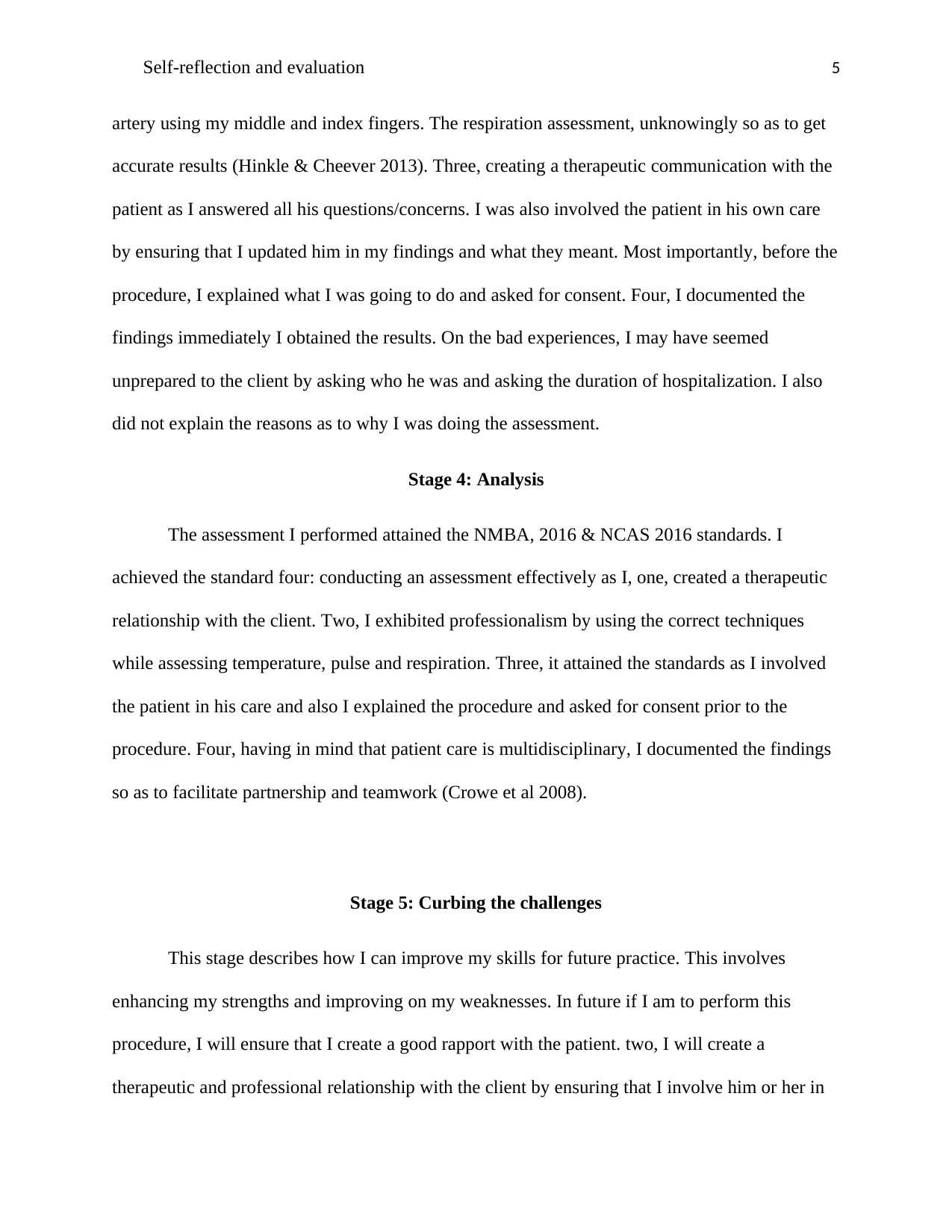
Self-reflection and evaluation 5
artery using my middle and index fingers. The respiration assessment, unknowingly so as to get
accurate results (Hinkle & Cheever 2013). Three, creating a therapeutic communication with the
patient as I answered all his questions/concerns. I was also involved the patient in his own care
by ensuring that I updated him in my findings and what they meant. Most importantly, before the
procedure, I explained what I was going to do and asked for consent. Four, I documented the
findings immediately I obtained the results. On the bad experiences, I may have seemed
unprepared to the client by asking who he was and asking the duration of hospitalization. I also
did not explain the reasons as to why I was doing the assessment.
Stage 4: Analysis
The assessment I performed attained the NMBA, 2016 & NCAS 2016 standards. I
achieved the standard four: conducting an assessment effectively as I, one, created a therapeutic
relationship with the client. Two, I exhibited professionalism by using the correct techniques
while assessing temperature, pulse and respiration. Three, it attained the standards as I involved
the patient in his care and also I explained the procedure and asked for consent prior to the
procedure. Four, having in mind that patient care is multidisciplinary, I documented the findings
so as to facilitate partnership and teamwork (Crowe et al 2008).
Stage 5: Curbing the challenges
This stage describes how I can improve my skills for future practice. This involves
enhancing my strengths and improving on my weaknesses. In future if I am to perform this
procedure, I will ensure that I create a good rapport with the patient. two, I will create a
therapeutic and professional relationship with the client by ensuring that I involve him or her in
artery using my middle and index fingers. The respiration assessment, unknowingly so as to get
accurate results (Hinkle & Cheever 2013). Three, creating a therapeutic communication with the
patient as I answered all his questions/concerns. I was also involved the patient in his own care
by ensuring that I updated him in my findings and what they meant. Most importantly, before the
procedure, I explained what I was going to do and asked for consent. Four, I documented the
findings immediately I obtained the results. On the bad experiences, I may have seemed
unprepared to the client by asking who he was and asking the duration of hospitalization. I also
did not explain the reasons as to why I was doing the assessment.
Stage 4: Analysis
The assessment I performed attained the NMBA, 2016 & NCAS 2016 standards. I
achieved the standard four: conducting an assessment effectively as I, one, created a therapeutic
relationship with the client. Two, I exhibited professionalism by using the correct techniques
while assessing temperature, pulse and respiration. Three, it attained the standards as I involved
the patient in his care and also I explained the procedure and asked for consent prior to the
procedure. Four, having in mind that patient care is multidisciplinary, I documented the findings
so as to facilitate partnership and teamwork (Crowe et al 2008).
Stage 5: Curbing the challenges
This stage describes how I can improve my skills for future practice. This involves
enhancing my strengths and improving on my weaknesses. In future if I am to perform this
procedure, I will ensure that I create a good rapport with the patient. two, I will create a
therapeutic and professional relationship with the client by ensuring that I involve him or her in
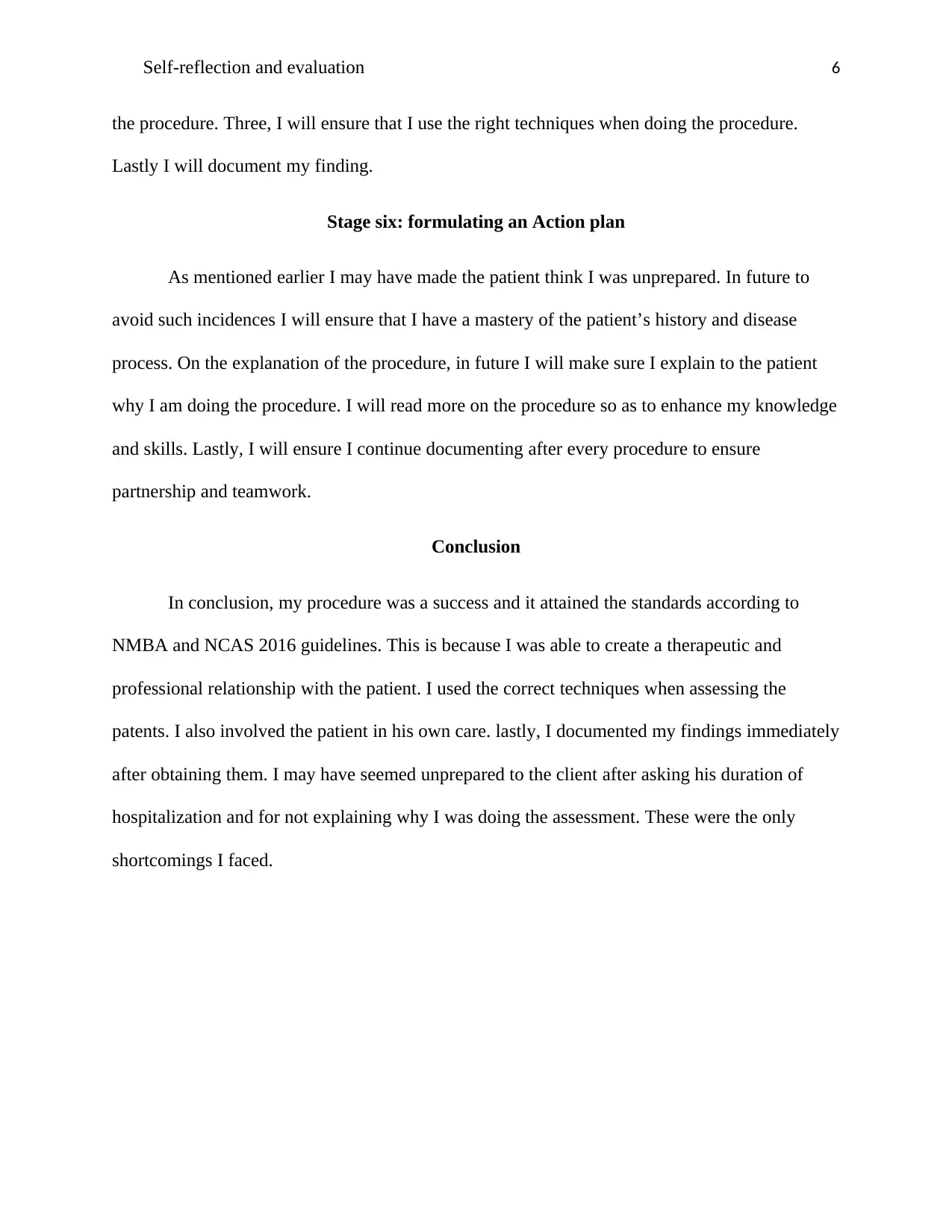
Self-reflection and evaluation 6
the procedure. Three, I will ensure that I use the right techniques when doing the procedure.
Lastly I will document my finding.
Stage six: formulating an Action plan
As mentioned earlier I may have made the patient think I was unprepared. In future to
avoid such incidences I will ensure that I have a mastery of the patient’s history and disease
process. On the explanation of the procedure, in future I will make sure I explain to the patient
why I am doing the procedure. I will read more on the procedure so as to enhance my knowledge
and skills. Lastly, I will ensure I continue documenting after every procedure to ensure
partnership and teamwork.
Conclusion
In conclusion, my procedure was a success and it attained the standards according to
NMBA and NCAS 2016 guidelines. This is because I was able to create a therapeutic and
professional relationship with the patient. I used the correct techniques when assessing the
patents. I also involved the patient in his own care. lastly, I documented my findings immediately
after obtaining them. I may have seemed unprepared to the client after asking his duration of
hospitalization and for not explaining why I was doing the assessment. These were the only
shortcomings I faced.
the procedure. Three, I will ensure that I use the right techniques when doing the procedure.
Lastly I will document my finding.
Stage six: formulating an Action plan
As mentioned earlier I may have made the patient think I was unprepared. In future to
avoid such incidences I will ensure that I have a mastery of the patient’s history and disease
process. On the explanation of the procedure, in future I will make sure I explain to the patient
why I am doing the procedure. I will read more on the procedure so as to enhance my knowledge
and skills. Lastly, I will ensure I continue documenting after every procedure to ensure
partnership and teamwork.
Conclusion
In conclusion, my procedure was a success and it attained the standards according to
NMBA and NCAS 2016 guidelines. This is because I was able to create a therapeutic and
professional relationship with the patient. I used the correct techniques when assessing the
patents. I also involved the patient in his own care. lastly, I documented my findings immediately
after obtaining them. I may have seemed unprepared to the client after asking his duration of
hospitalization and for not explaining why I was doing the assessment. These were the only
shortcomings I faced.
⊘ This is a preview!⊘
Do you want full access?
Subscribe today to unlock all pages.

Trusted by 1+ million students worldwide
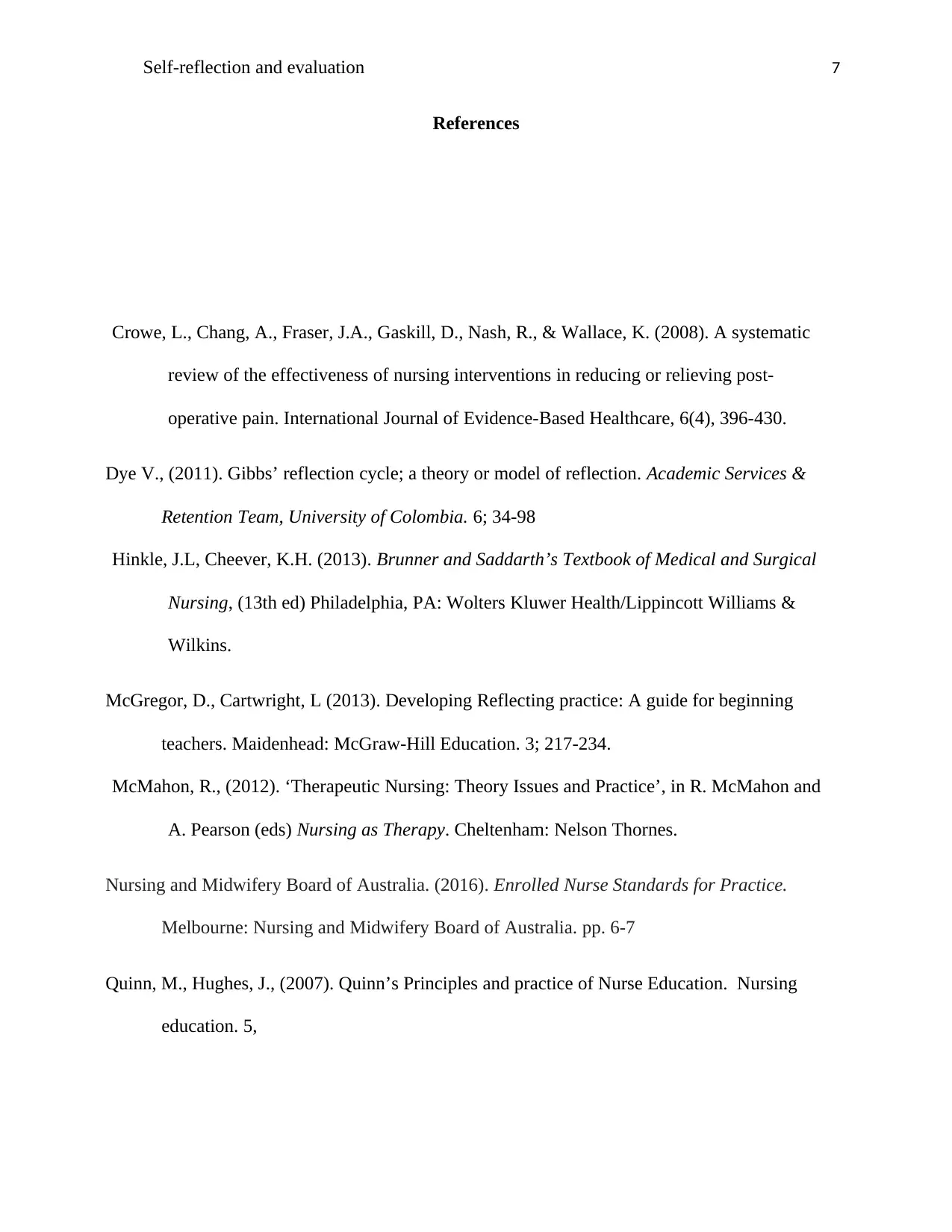
Self-reflection and evaluation 7
References
Crowe, L., Chang, A., Fraser, J.A., Gaskill, D., Nash, R., & Wallace, K. (2008). A systematic
review of the effectiveness of nursing interventions in reducing or relieving post-
operative pain. International Journal of Evidence-Based Healthcare, 6(4), 396-430.
Dye V., (2011). Gibbs’ reflection cycle; a theory or model of reflection. Academic Services &
Retention Team, University of Colombia. 6; 34-98
Hinkle, J.L, Cheever, K.H. (2013). Brunner and Saddarth’s Textbook of Medical and Surgical
Nursing, (13th ed) Philadelphia, PA: Wolters Kluwer Health/Lippincott Williams &
Wilkins.
McGregor, D., Cartwright, L (2013). Developing Reflecting practice: A guide for beginning
teachers. Maidenhead: McGraw-Hill Education. 3; 217-234.
McMahon, R., (2012). ‘Therapeutic Nursing: Theory Issues and Practice’, in R. McMahon and
A. Pearson (eds) Nursing as Therapy. Cheltenham: Nelson Thornes.
Nursing and Midwifery Board of Australia. (2016). Enrolled Nurse Standards for Practice.
Melbourne: Nursing and Midwifery Board of Australia. pp. 6-7
Quinn, M., Hughes, J., (2007). Quinn’s Principles and practice of Nurse Education. Nursing
education. 5,
References
Crowe, L., Chang, A., Fraser, J.A., Gaskill, D., Nash, R., & Wallace, K. (2008). A systematic
review of the effectiveness of nursing interventions in reducing or relieving post-
operative pain. International Journal of Evidence-Based Healthcare, 6(4), 396-430.
Dye V., (2011). Gibbs’ reflection cycle; a theory or model of reflection. Academic Services &
Retention Team, University of Colombia. 6; 34-98
Hinkle, J.L, Cheever, K.H. (2013). Brunner and Saddarth’s Textbook of Medical and Surgical
Nursing, (13th ed) Philadelphia, PA: Wolters Kluwer Health/Lippincott Williams &
Wilkins.
McGregor, D., Cartwright, L (2013). Developing Reflecting practice: A guide for beginning
teachers. Maidenhead: McGraw-Hill Education. 3; 217-234.
McMahon, R., (2012). ‘Therapeutic Nursing: Theory Issues and Practice’, in R. McMahon and
A. Pearson (eds) Nursing as Therapy. Cheltenham: Nelson Thornes.
Nursing and Midwifery Board of Australia. (2016). Enrolled Nurse Standards for Practice.
Melbourne: Nursing and Midwifery Board of Australia. pp. 6-7
Quinn, M., Hughes, J., (2007). Quinn’s Principles and practice of Nurse Education. Nursing
education. 5,
Paraphrase This Document
Need a fresh take? Get an instant paraphrase of this document with our AI Paraphraser
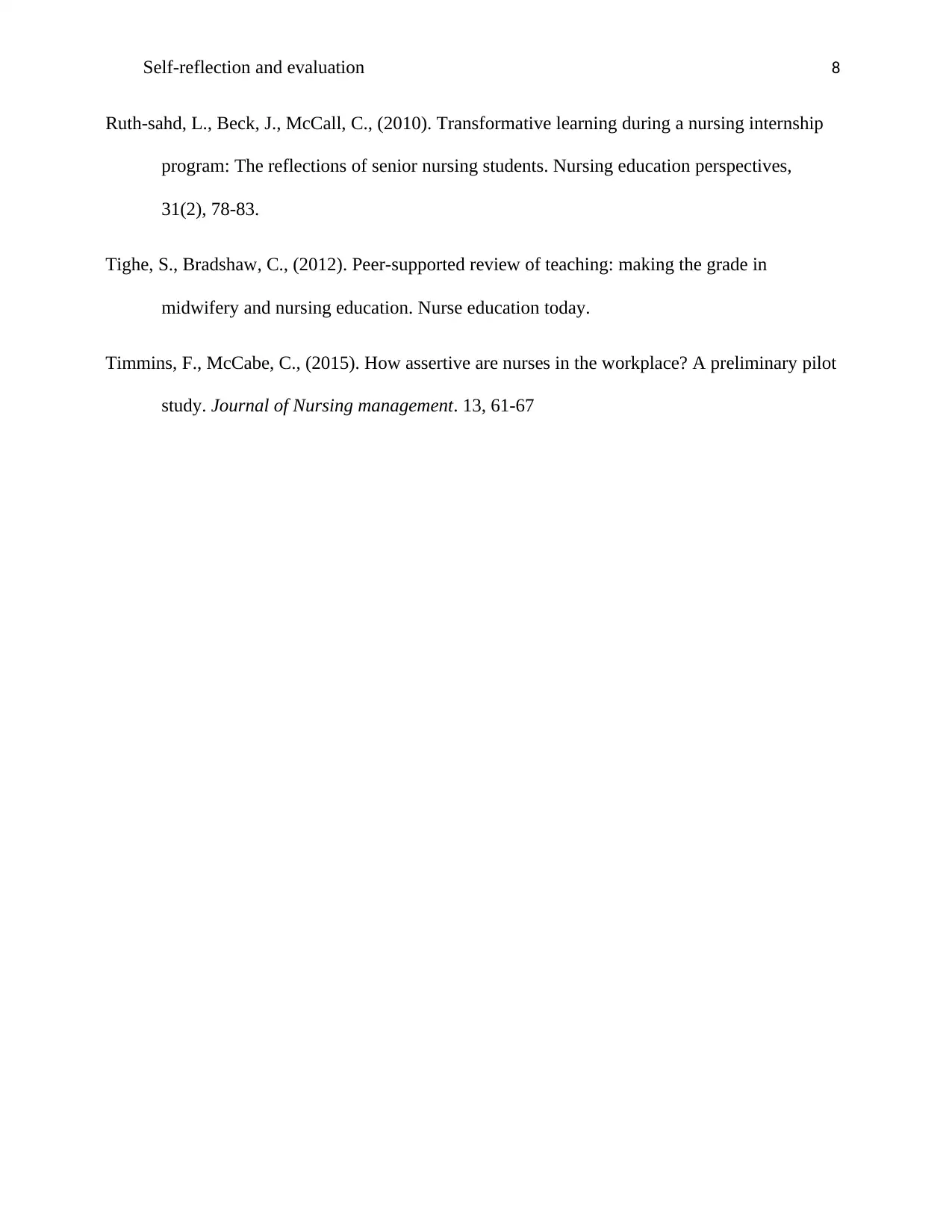
Self-reflection and evaluation 8
Ruth-sahd, L., Beck, J., McCall, C., (2010). Transformative learning during a nursing internship
program: The reflections of senior nursing students. Nursing education perspectives,
31(2), 78-83.
Tighe, S., Bradshaw, C., (2012). Peer-supported review of teaching: making the grade in
midwifery and nursing education. Nurse education today.
Timmins, F., McCabe, C., (2015). How assertive are nurses in the workplace? A preliminary pilot
study. Journal of Nursing management. 13, 61-67
Ruth-sahd, L., Beck, J., McCall, C., (2010). Transformative learning during a nursing internship
program: The reflections of senior nursing students. Nursing education perspectives,
31(2), 78-83.
Tighe, S., Bradshaw, C., (2012). Peer-supported review of teaching: making the grade in
midwifery and nursing education. Nurse education today.
Timmins, F., McCabe, C., (2015). How assertive are nurses in the workplace? A preliminary pilot
study. Journal of Nursing management. 13, 61-67
1 out of 8
Related Documents
Your All-in-One AI-Powered Toolkit for Academic Success.
+13062052269
info@desklib.com
Available 24*7 on WhatsApp / Email
![[object Object]](/_next/static/media/star-bottom.7253800d.svg)
Unlock your academic potential
Copyright © 2020–2025 A2Z Services. All Rights Reserved. Developed and managed by ZUCOL.





